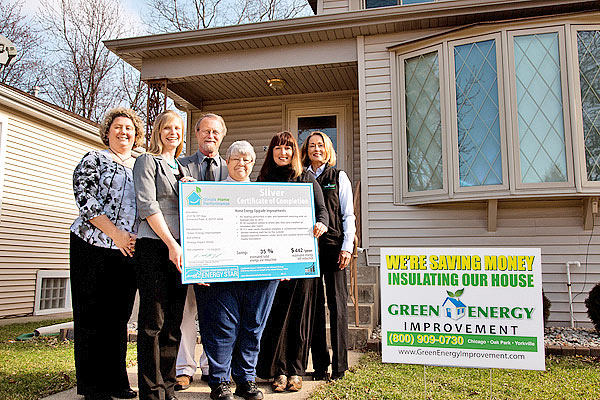
From left: Alyson Grady (Illinois Energy Office), Jamie Peters (Midwest Energy Efficiency Alliance), Bruce Selway (Illinois Energy Office), Kimberly Radostits (Green Energy Improvement), and Bonita Marx (Green Energy Improvement) as Janet Jaback (center) receives her Energy Star Silver Certificate.
With an increasing share of homebuyers putting energy efficiency and other green features at or near the top of their wish list, the Chicago-area multiple listing service is giving environmentally friendly features more prominence. Last week, Midwest Real Estate Data (MRED) added a Walk Score; it’s a measure of how many services can be accessed from a home without driving. And early next week it will add new searchable fields for a home’s green improvements and third-party certifications.
While agents have been able to denote a house as green before, the available fields were broad enough to lead to some inadvertent “greenwashing.” As Sarah Coulter, an @Properties agent who has been a leader in greening up MRED’s listings, explains, a house with a handful of Energy Star-rated appliances wasn’t easily distinguished from one whose green-ness was in the form of low-VOC paints and cabinetry.
The upgrades, which provide a way for a listing agent to attach certification forms from LEED, HERS, Energy Impact Illinois, and other third-party verifiers, will facilitate shopping for homes with the specific green attributes that are important to would-be buyers, Coulter says.
For a seller who has invested in green upgrades—from attic insulation to solar heat for the home’s hot water—these fields provide a marketing edge, a chance to advertise the green advantage their home has over comparable properties. And the Walk Score is like icing on the cake; you can’t do much to improve your home’s walkability, but if it scores high, you can tout that.
At the same time, “having these green fields on the MLS and showing that more and more people are choosing to use them will help create demand for more green new homes and [renovations],” Coulter says. “That propels green building, which has an effect on our homes, our pocketbooks, our health, and our world.”
Unable to be interviewed while traveling, Russ Bergeron, MRED’s CEO, said in an email that home-shoppers “are making decisions today based on Green [sic]—not only Green ratings, certifications and appliances, but also the green in their pocketbooks. Energy efficiency saves you money.”
Janet Jaback recently spent just less than $4,000 on energy-efficient upgrades to the Elmwood Park bungalow where she has lived for 30 years. The work, done by Green Energy Improvement, enhanced the insulation in the basement and attic and sealed gaps in the house that let in cold air. Her January energy bill, the first since the work was completed, was down 30 percent from January 2011 (when, it should be noted, we had colder temperature averages than we had this January). In the long run, Jaback says that she expects the energy savings to pay for themselves in about three years.
Earlier this month, Jaback and Green Energy Improvement received the first Energy Star Silver Certificate, third-party acknowledgement of the home’s green-ness. At the moment, her home is not for sale—it’s been on and off the market for a few years, at $245,000—but Jaback says that when she is ready to try selling it again (probably in 2013), the certification will be a big factor in marketing the bungalow.
“If I were buying in Elmwood Park and I saw this house is already greener than the others that are for sale, and I could save $200 a month living there, I’d say, ‘By golly, I’m going to do it,’” Jaback says. “More people are apt to look at a house because of its bottom line being better.”
Photograph: Mark Segal Photography


